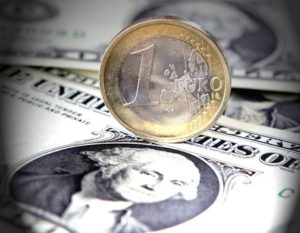 Yesterday’s trade saw EUR/USD within the range of 1.1540-1.1677. The pair closed at 1.1610, gaining 0.52% on a daily basis.
Yesterday’s trade saw EUR/USD within the range of 1.1540-1.1677. The pair closed at 1.1610, gaining 0.52% on a daily basis.
On Wednesday the cross touched lows unseen since November 11th 2003 at 1.1539.
At 7:58 GMT today EUR/USD was down 0.23% for the day to trade at 1.1582. The pair touched a daily low at 1.1576 at 7:30 GMT.
Fundamentals
Euro zone
Italian retail sales
Annualized retail sales in Italy probably decreased at a pace of 0.2% in November, according to the median estimate by experts, following another 0.8% drop in October. If so, this would be the seventh consecutive month of decline in sales. In monthly terms, seasonally adjusted retail sales probably fell 0.1% in November, after remaining flat in October. This indicator reflects the change in the total value of inflation-adjusted sales by retailers in the country and provides key information regarding consumer spending trend, while the latter is a key driving force behind economic growth. In case the retail sales index dropped at a faster-than-expected pace, this might have a limited bearish effect on the euro. The National Institute of Statistics (Istat) is expected to release the official report at 10:00 GMT.
ECB policy decision
At 12:45 GMT the European Central Bank (ECB) is to announce its decision in regard to borrowing costs. The median estimate by experts suggests that the central bank will probably maintain its benchmark interest rate at the record low level of 0.05% at the policy meeting today. The bank last reduced the refinancing rate by 10 basis points to the current 0.05% at the September 4th meeting. This has been the fourth time last year, when the ECB cut its benchmark.
At its meeting on December 4th the central bank kept the marginal lending facility intact at 0.30% and the deposit facility at -0.20%. The bank has also significantly revised down its economic growth forecasts, stressing that the risks remain on the “downside”.
According to extracts from the Introductory statement to the press conference, offered by ECB President, Mario Draghi: ”As regards our non-standard monetary policy measures, we have started purchasing covered bonds and asset-backed securities. These purchase programmes will last for at least two years. Next week, we will conduct the second targeted longer-term refinancing operation, to be followed by six further operations until June 2016. Taken together, our measures will have a sizeable impact on our balance sheet, which is intended to move towards the dimensions it had at the beginning of 2012.”
”In the coming months, our measures will further ease the monetary policy stance more broadly, support our forward guidance on the key ECB interest rates and reinforce the fact that there are significant and increasing differences in the monetary policy cycle between major advanced economies. However, the latest euro area macroeconomic projections indicate lower inflation, accompanied by weaker real GDP growth and subdued monetary dynamics.”
“Real GDP in the euro area rose by 0.2%, quarter on quarter, in the third quarter of this year. This was in line with earlier indications of a weakening in the euro area’s growth momentum, leading to a downward revision of the outlook for euro area real GDP growth in the most recent forecasts. The latest data and survey evidence up to November confirm this picture of a weaker growth profile in the period ahead.”
“These elements are reflected in the December 2014 Eurosystem staff macroeconomic projections for the euro area, which foresee annual real GDP increasing by 0.8% in 2014, 1.0% in 2015 and 1.5% in 2016.”
At the policy meeting today the ECB is projected to begin purchasing sovereign bonds in order to spur demand and fight deflation in a shorter term.
ECB policy makers will probably launch a 550 billion-euro bond-purchasing program, according to the median estimate of economists, participated in a Bloomberg survey, which would exceed the 500-billion-euro models, presented to ECB officials earlier in January.
However, concerns emerged that longer-term effects on growth and inflation in the region, caused by the possible Quantitative Easing, may remain restrained.
According to an excerpt from an article published on the openeurope.org.uk website on December 19th: ”Many assume that QE on sovereign debt can have the same impact as it did in the US and UK. However, the economics and politics of the Eurozone are fundamentally different; the single currency bloc is at a wholly different stage of the crisis than when QE was launched in these countries. At the same time, QE will come with a range of political costs. That could come back to haunt the Eurozone in the long-term or lead to the programme being watered down, further limiting its effectiveness.”
ECB policy makers aim to keep prices in the region stable, while stability is defined as a year-on-year increase in the Harmonized Index of Consumer Prices (HICP) for the Euro zone of below, but close to 2%.
Short-term interest rates are of utmost importance for the valuation of national currencies. In case the European Central Bank is dovish about inflationary pressure and overall economic activity in the Euro area and, thus, either puts interest rates on hold, or reduces them further, this will usually cause a bearish impact on the common currency.
The interest rate decision is to be followed by the press conference with ECB President Mario Draghi, during which volatility of euro crosses is usually high. In case Draghi offers a more hawkish tone, the euro will usually receive support, while a more dovish tone will have a bearish effect on the currency. The press conference is scheduled at 13:30 GMT.
Euro area Consumer confidence – preliminary estimate
Confidence among consumers in the Euro area probably improved in January. The preliminary value of the consumer confidence index probably rose to -10.5 from a final value of -11.5 in December. If so, this would be the highest level of confidence since August, when the indicator was reported at a final value of -10.0. The index measures consumer confidence on a scale of -100 to +100. A reading of -100 suggests a lack of confidence, zero means neutrality and a reading of +100 indicates extreme levels of confidence. The index reflects the level of optimism, which consumers have about economic development in the region. The Business and Consumer Survey is conducted by phone and includes 23 000 households in the Euro area. The questions asked stress on current economic and financial situation, savings intention and also on expected developments regarding consumer price indexes, general economic situation and major purchases of durable goods. This indicator is one of the five major components, that comprise the Economic Sentiment Indicator (ESI).
Higher confidence usually implies greater willingness to spend, including large-ticket purchases, while consumer spending is a key factor behind economic growth. Therefore, in case the consumer confidence index improved more than anticipated, this would cause a bullish impact on the euro. The European Commission is expected to release the preliminary reading at 15:00 GMT.
United States
Initial, Continuing jobless claims
The number of people in the United States, who filed for unemployment assistance for the first time during the week ended on January 16th, probably decreased to 300 000 from 316 000 in the prior week. The latter has been the highest level since the week ended on September 5th. The 4-week moving average, an indicator lacking seasonal effects, was 298 000, marking an increase of 6 750 from the previous weeks revised up average of 291 250.
Initial jobless claims number is a short-term indicator, reflecting lay-offs in the country. In case the number of claims fell more than projected, this would have a bullish effect on the greenback.
The number of continuing jobless claims probably fell to the seasonally adjusted 2 410 000 during the week ended on January 9th, from 2 424 000 in the previous week. The latter was a decrease by 51 000 compared to the revised up number of claims, reported during the week ended on January 2nd. This indicator represents the actual number of people unemployed and currently receiving unemployment benefits, who filed for unemployment assistance at least two weeks ago.
The Department of Labor is to release the weekly report at 13:30 GMT.
Pivot Points
According to Binary Tribune’s daily analysis, the central pivot point for the pair is at 1.1609. In case EUR/USD manages to breach the first resistance level at 1.1678, it will probably continue up to test 1.1746. In case the second key resistance is broken, the pair will probably attempt to advance to 1.1815.
If EUR/USD manages to breach the first key support at 1.1541, it will probably continue to slide and test 1.1472. With this second key support broken, the movement to the downside will probably continue to 1.1404.
The mid-Pivot levels for today are as follows: M1 – 1.1438, M2 – 1.1507, M3 – 1.1575, M4 – 1.1644, M5 – 1.1712, M6 – 1.1781.
In weekly terms, the central pivot point is at 1.1633. The three key resistance levels are as follows: R1 – 1.1808, R2 – 1.2046, R3 – 1.2221. The three key support levels are: S1 – 1.1395, S2 – 1.1220, S3 – 1.0982.





